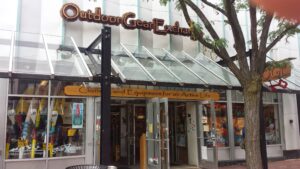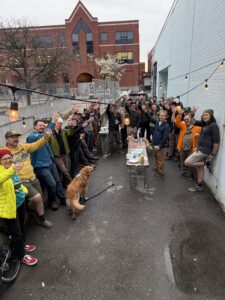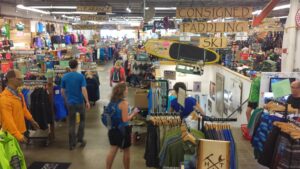Switchback at TRE, December 2-4, 2025 in San Antonio, TX
•
Switchback Spring, June 16-18, 2026 in New Orleans, LA
 Consignment stores and second-hand gear are super trendy these days, but Outdoor Gear Exchange (OGE) in Burlington, VT, has specialized in selling affordable used products for 30 years.
Consignment stores and second-hand gear are super trendy these days, but Outdoor Gear Exchange (OGE) in Burlington, VT, has specialized in selling affordable used products for 30 years.
In 1995, OGE Owner Marc Sherman was camping with friends in the Adirondacks when he realized his fellow campers lacked quality outdoor gear while he had a surplus of it. Sherman had been working for the Vermont Teddy Bear Company and was seeking a new career, so he devised a plan to open an outdoor store featuring second-hand goods.
“I was 29 and didn’t have any significant debt or obligations, so what better time to open a business in the outdoor field?” says Sherman.
He contacted Jerry Jordan, owner of Wilderness Exchange, an outdoor consignment store in Berkeley, CA. “During a three-hour call, he more or less helped us write our business plan, and we launched a few months later,” says Sherman.
As OGE celebrates its 30th Anniversary this year, it remains a popular fixture in Burlington, VT, and a well-known pioneer of consignment sales in the outdoor industry.
While OGE launched as a small shop mainly selling used items, the business has grown significantly and now features a 44,000-square-foot store that offers a greater range of used goods, as well as non-consignment in-line products for various activities, including hiking, climbing, paddling, cycling, and backcountry skiing.
 As OGE has grown in size and scope, it has also adapted to numerous changes in the business world, including shifts in e-commerce, consumer behavior, and developments within the outdoor recreation industry. Still, the company remains true to its roots, offering customers affordable gear and expert advice from knowledgeable, well-trained employees.
As OGE has grown in size and scope, it has also adapted to numerous changes in the business world, including shifts in e-commerce, consumer behavior, and developments within the outdoor recreation industry. Still, the company remains true to its roots, offering customers affordable gear and expert advice from knowledgeable, well-trained employees.
Concentrating on Consignment
Long before second-hand sales became a popular trend, OGE embraced the concept, and today, the store is known for its extensive selection of used items.
When OGA opened in 1995, the entire shop measured only 800 square feet, which allowed the store to offer a limited selection of products, including socks, water bottles, accessories, and a few hardgoods. “It was mostly consignment items and some sales rep samples,” says Sherman. “We had a bunch of Alps Mountaineering prototypes.”
The OGE store now dedicates 4,000 square feet to consignment gear and clothing.
“That piece of our business has grown consistently throughout our history, including during the slower past couple of years as the industry’s been compressing,” says Sherman. “On a Saturday, the number of units of consignment goods that go out the door is just phenomenal.”
OGE customers often visit that section of the store several times a week to see what has arrived, says Sherman, adding that there are dedicated racks for The North Face and Patagonia, the store’s two most popular brands for used apparel.
Reducing Online Sales
In addition to being known for its consignment business, OGE is also recognized as an early adopter of e-commerce. “We started selling online in 1997,” says Sherman. “We weren’t processing transactions online, but we were taking orders and shipping them out.”
OGE’s online business reached its peak during the pandemic, with its website and Amazon marketplace account generating 50% of sales. However, online sales are becoming less critical for the business.
“In the last year or so, we’ve seen our online business shrink significantly,” says Sherman, noting that the pandemic created a glut of inventory that affected prices for online sellers. “The price competition was hard to manage and not beneficial to us,” says Sherman. Additionally, Amazon reduced margins for vendors, prompting OGE to exit the Fulfillment by Amazon program.
According to Sherman, OGE’s shift away from online sales is also due to changes in consumer behavior. “In general, I think things are shifting back to in-person retail,” he says, adding that this works to OGE’s advantage. “Our value proposition has always been our broad range of price points and our in-person service,” says Sherman.
Empowering Employees
OGE excels at in-person service due to its knowledgeable and experienced staff, says Sherman, noting that most employees spend a great deal of time testing gear outdoors and participating in clinics. Additionally, approximately 20 of the 75 store employees have been with OGE for many years.
“When our staff works with you, they’re not just reading the box for details about the item,” says Sherman. “They know that item. They have experience using it.”
While employees explore the outdoors on their off days, they can also utilize the store’s sabbatical programs to pursue adventures. Under the program, employees can double their accrued PTO and take that amount of time off unpaid, still receiving their insurance and other benefits. Additionally, the store aims to remove barriers that prevent employees from purchasing the necessary gear.
 “We offer people an account so that if they’re heading out for the weekend and need something but may not be able to afford it that day, they can put it on account,” says Sherman. Additionally, the store offers employees the option to pay for large purchases, such as bicycles, over time through the store’s financing program.
“We offer people an account so that if they’re heading out for the weekend and need something but may not be able to afford it that day, they can put it on account,” says Sherman. Additionally, the store offers employees the option to pay for large purchases, such as bicycles, over time through the store’s financing program.
Modifying Digital Marketing
When OGE employees get outdoors and explore, they sometimes chronicle their adventures on OGE’s blog, which is becoming an increasingly important part of the company’s digital marketing strategy.
According to Sherman, the store had invested heavily in paid social media advertising, but that strategy is no longer as effective. “I don’t know whether the social channels have become overrun with unnecessary content and people aren’t paying attention, or it’s just not where people are going to buy stuff. So, we’re realigning our social media to be driven more by organic content,” says Sherman. “We’re focusing on our blog content right now because it really does generate more interest.”
The store is also investing less in growing its website traffic. “We were working with people who got us better traffic on our website, but it was unqualified traffic, so the conversion rate dropped,” says Sherman. Instead, OGE is concentrating more on e-mail marketing and regularly contacts 10,000 to 20,000 customers. “We know they’re interested in what we sell and already have an affiliation with the store in one way or another,” he says.
Looking to the Future
While OGE has successfully adapted to changes in the business world, Sherman foresees a challenging future for the outdoor industry. “The entire market is shrinking, and I think we need to come to terms with how big we can be,” he says. “I don’t think the revenue models support us being as big as we once were, and all of our businesses need to think about how much gear we can support and how much gear needs to be replaced every year.”
Still, he does see bright spots. “I do think that the industry has focused on kids, and that’s been important because you not only get kids out, but you get their parents out,” he says. “The outdoors is always going to be a source of resilience and strength for people, whether they’re getting outside for exercise or mental health.”
